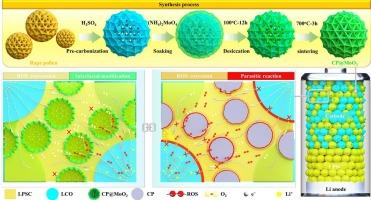Engineering multifunctional conductive carbon-based cathode additives to stabilize high-performance all-solid-state lithium metal batteries
IF 22
1区 材料科学
Q1 MATERIALS SCIENCE, MULTIDISCIPLINARY
引用次数: 0
Abstract
Exceptional electrochemical performances of all-solid-state lithium metal batteries (ASSLMBs) can be achieved by effectively inhibiting damaging of reactive oxygen species (ROSs) formed by oxidation of the inevitably present surface groups on the carbon-based conductive agents (CCAs) and upon charging transition metal oxide based cathodes. Herein, we report on the use of highly effective novel CCA additive based on biomass-derived carbonaceous nanomaterials produced from carbonized pollen uniformly coated by nano MoO2 through a bio-templating method (CP@MoO2) in composite high energy cathodes of ASSLMBs. The rational design of this porous nano-composite additive not only makes it difficult for oxygen-containing functional groups to survive on the surface, but also promotes electrocatalytic adsorption and transformation of ROSs within composite cathodes, thus avoiding their detrimental effects. And rapid and homogeneous conductions of Li+/e− within the composite cathodes are ensured thanks to the use of the CP@MoO2 additive. As a result, ASSLMBs employing typical LiCoO2 and promising Li-rich Mn-based oxide cathodes could demonstrate excellent cycling stability retaining 99.9 % of discharge capacity after 500 cycles at 0.2C and display capacity retention of over 87 % after 3000 cycles at 5C with a steady average coulombic efficiency (>99.98 %).

工程多功能导电碳基阴极添加剂稳定高性能全固态锂金属电池
通过有效抑制碳基导电剂(CCAs)表面基团氧化和过渡金属氧化物阴极充电所形成的活性氧(ROSs)的破坏,可以实现全固态锂金属电池(asslbs)优异的电化学性能。在此,我们报道了一种高效的新型CCA添加剂,该添加剂基于生物质衍生的碳质纳米材料,该材料由碳化花粉制成,通过生物模板法(CP@MoO2)均匀涂覆纳米MoO2,用于asslmb复合高能阴极。该多孔纳米复合添加剂的合理设计不仅使含氧官能团难以在表面存活,而且促进了复合阴极内ROSs的电催化吸附和转化,从而避免了其有害影响。由于使用了CP@MoO2添加剂,复合阴极内Li+/e−的快速均匀导电得到了保证。结果表明,采用典型LiCoO2和富锂锰基氧化物阴极的asslmb在0.2C下循环500次后仍能保持99.9%的放电容量,在5C下循环3000次后仍能保持87%以上的放电容量,平均库仑效率稳定(> 99.98%)。
本文章由计算机程序翻译,如有差异,请以英文原文为准。
求助全文
约1分钟内获得全文
求助全文
来源期刊

Materials Today
工程技术-材料科学:综合
CiteScore
36.30
自引率
1.20%
发文量
237
审稿时长
23 days
期刊介绍:
Materials Today is the leading journal in the Materials Today family, focusing on the latest and most impactful work in the materials science community. With a reputation for excellence in news and reviews, the journal has now expanded its coverage to include original research and aims to be at the forefront of the field.
We welcome comprehensive articles, short communications, and review articles from established leaders in the rapidly evolving fields of materials science and related disciplines. We strive to provide authors with rigorous peer review, fast publication, and maximum exposure for their work. While we only accept the most significant manuscripts, our speedy evaluation process ensures that there are no unnecessary publication delays.
 求助内容:
求助内容: 应助结果提醒方式:
应助结果提醒方式:


